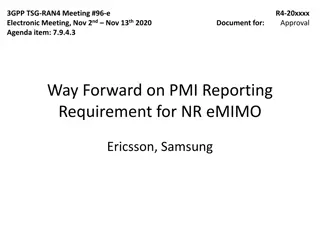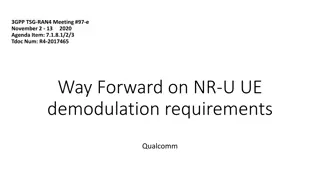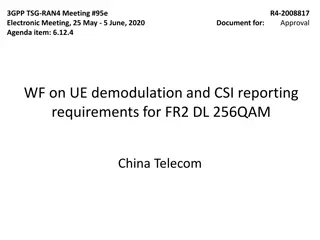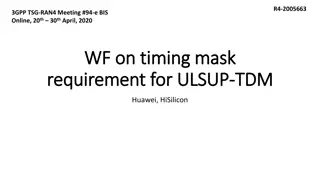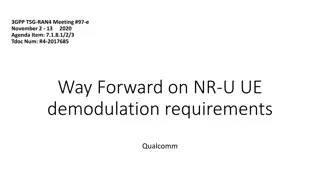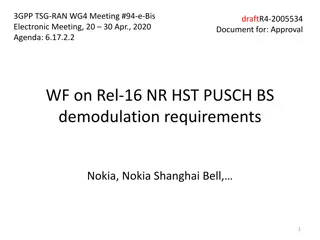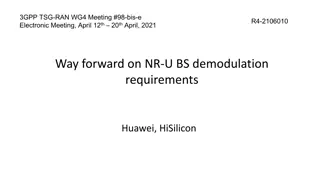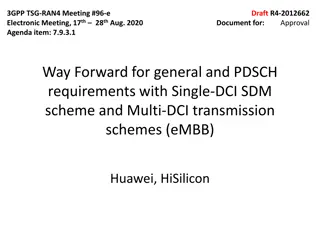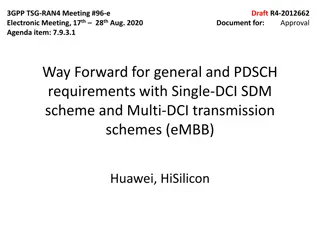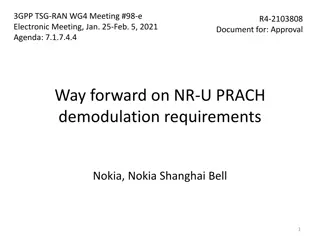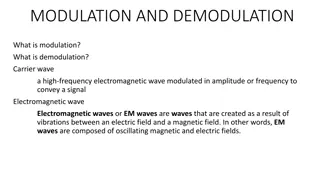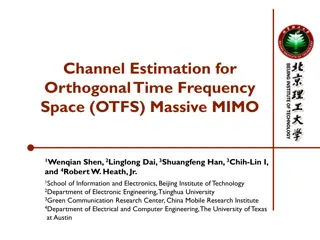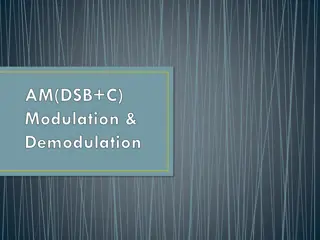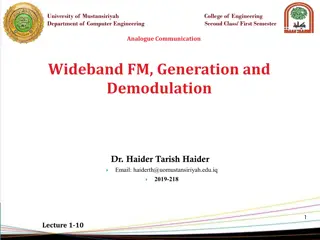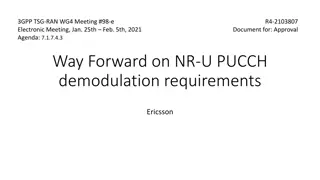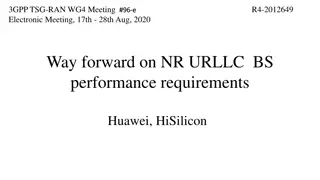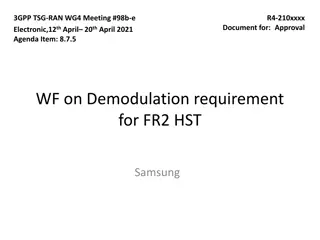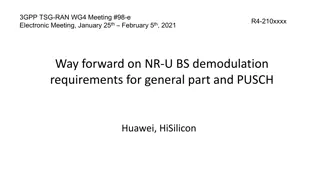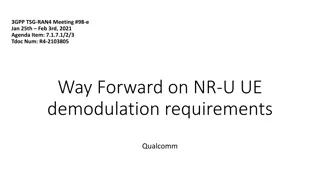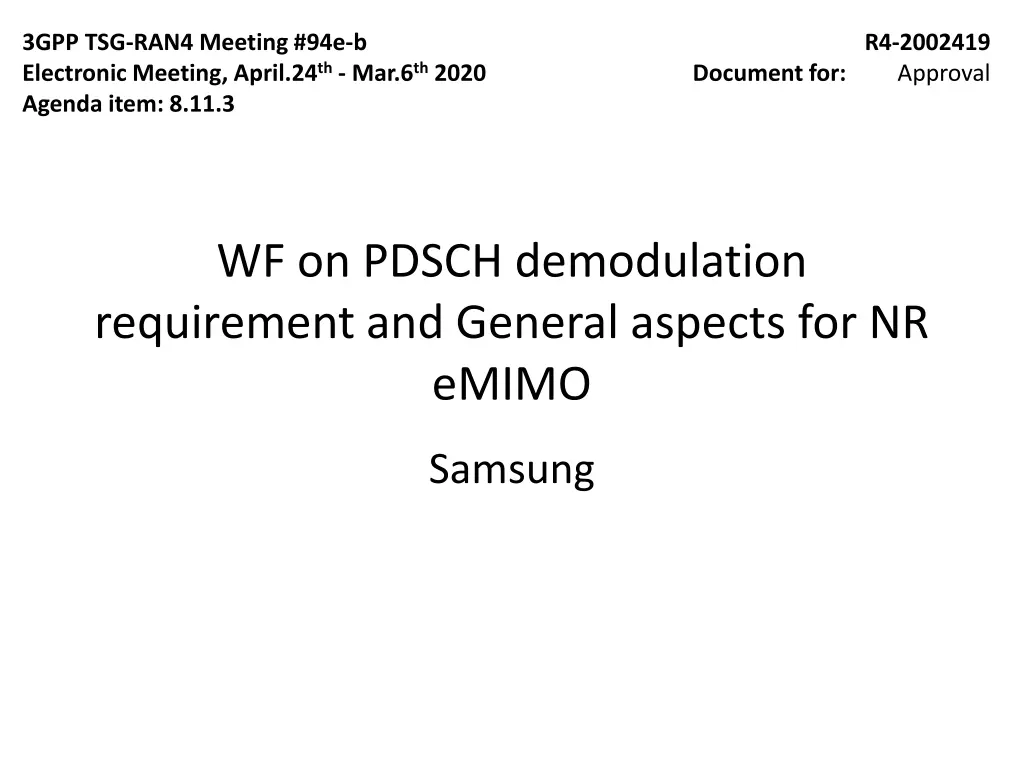
PDSCH Demodulation Requirement and Test Setup for NR eMIMO
Explore the approval document for the WF on PDSCH demodulation requirement and general aspects for NR eMIMO from the 3GPP TSG-RAN4 Meeting. Review the agreed WFs, enhancement scope, and test setups related to low PAPR, RS, DMRS enhancements, PDSCH requirements, and multi-TRP/Panel configurations for eMBB. Delve into the detailed test scenarios and applicability rules outlined for conducting tests based on UE capability in the context of PDSCH requirements with multi-TRP/Panel for eMBB.
Download Presentation

Please find below an Image/Link to download the presentation.
The content on the website is provided AS IS for your information and personal use only. It may not be sold, licensed, or shared on other websites without obtaining consent from the author. If you encounter any issues during the download, it is possible that the publisher has removed the file from their server.
You are allowed to download the files provided on this website for personal or commercial use, subject to the condition that they are used lawfully. All files are the property of their respective owners.
The content on the website is provided AS IS for your information and personal use only. It may not be sold, licensed, or shared on other websites without obtaining consent from the author.
E N D
Presentation Transcript
3GPP TSG-RAN4 Meeting #94e-b Electronic Meeting, April.24th- Mar.6th2020 Agenda item: 8.11.3 R4-2002419 Approval Document for: WF on PDSCH demodulation requirement and General aspects for NR eMIMO Samsung
Background Agreed WFs for demodulation requirement for NR eMIMO WI in previous meetings R4-2002419 WF on demodulation and CSI requirement for NR eMIMO, RAN4#94-e R4-2002420 WF on PDSCH demodulation requirements based on multi-TRP transmission for NR eMIMO, RAN4#94-e
Test Scope of Enhancement on low PAPR RS requirement No new PDSCH requirement with Rel-16 DMRS enhancement for CP-OFDM No new PUSCH requirement with Rel-16 DMRS enhancement for CP-OFDM
Test Scope of PDSCH requirement with multi-TRP/Panel for eMBB Whether to define PDSCH requirement scheduled by single-DCI based multi-TRP/Panel transmission for eMBB Option 1: Yes (Samsung, Intel, QC) Option 2: No (Huawei, Ericsson) Applicability rule FFS on test applicability rule between single-DCI and multi-DCI based multi-TRP/Panel transmission for conducting the tests based on UE capability
General test setup for PDSCH requirements with multi-TRP/Panel for eMBB Test scenario FR1: Define PDSCH requirement with cover scenarios with simultaneous reception from multi-TRP/Panel for eMBB FR2: No PDSCH requirements with serval impendent Rx beam and simultaneous reception from multi-TRP/Panel for eMBB in FR2 FFS on define PDSCH with covering scenarios with only 1 Rx beam with and simultaneous reception from multi-TRP/Panel for eMBB SCS and CBW FR1 FDD SCS =15KHz, 10 MHz TDD SCS =30KHz, 40 MHZ FFS for FR2 TDD SCS =120KHz, 100 MHz
General test setup for PDSCH requirements with multi-TRP/Panel for eMBB TCI state configuration and QCI-info for FR1 TCI index Information FR1 Type 1 QCL information SSB index SSB #0 TCI state #0 QCL Type SSB index QCL Type Type C N/A N/A Type 2 QCL information CSI-RS resource 1 from CSI- RS for tracking configuration Type A N/A N/A CSI-RS resource 2 from CSI- RS for tracking configuration Type A N/A N/A Type 1 QCL information CSI-RS resource TCI state #1 QCL Type CSI-RS resource QCL Type Type 2 QCL information Type 1 QCL information CSI-RS resource TCI state #2 QCL Type CSI-RS resource QCL Type Type 2 QCL information
General test setup for PDSCH requirements with multi-TRP/Panel for eMBB FFS on TCI state configuration and QCI-info for FR2 TCI index Information FR2 SSB #0 Type C SSB #0 Type D Type 1 QCL information Type 2 QCL information SSB index QCL Type SSB index QCL Type TCI state #0 CSI-RS resource 1 from CSI-RS for tracking configuration Type A CSI-RS resource 1 from CSI-RS for tracking configuration Type D CSI-RS resource 2 from CSI-RS for tracking configuration Type A CSI-RS resource 1 from CSI-RS for tracking configuration Type D Type 1 QCL information CSI-RS resource QCL Type TCI state #1 Type 2 QCL information CSI-RS resource QCL Type Type 1 QCL information CSI-RS resource QCL Type TCI state #2 Type 2 QCL information CSI-RS resource QCL Type
General test setup for PDSCH requirements with multi-TRP/Panel for eMBB Assumption for UE receiver implementation The test case design should be ensure receiver implementation agnostic with assumption of single FFT operation Set BS antenna correlation between two TRPs as 0 PDSCH decoding Separate decoding of each PDSCH scheduled by multi-DCI (Huawei, Qualcomm, Intel) Whether to consider the scenario with TRS/CSI-RS collide between 2 TRPs Option 1: Yes (Ericsson) Option 2: No(Qualcomm, Intel, Huawei, Samsung)
General test setup for PDSCH requirements with multi-TRP/Panel for eMBB Timing offset configuration Define with timing offset between two TRPs, the timing offset setting should be ensured that all paths from TRPs are within CP Set timing offset by scaled with SCS t = 2 t1
General test setup for PDSCH requirements with multi-TRP/Panel for eMBB Timing offset configuration Study suitable upper bounds on propagation delay difference. The following values can be used from LTE Rel-11 CoMP (- 0.5us and 2us) as a starting point FR1 FDD (15KHz SCS) Positive upper bound Option 1: [2] us (Samsung, Intel, Huawei, Ericsson) Other options are not precluded FFS on Negative upper bound FR1 TDD (30KHz SCS) Positive upper bound Option 1: [1] us (Samsung, Huawei, Ericsson) Option 2: [2] us (Intel) Other options are not precluded FFS on Negative upper bound FFS on FR2 TDD (120 KHz) Positive upper bound Option 1: [0.25] us (Samsung, Ericsson) Other options are not precluded FFS on Negative upper bound
General test setup for PDSCH requirements with multi-TRP/Panel for eMBB Frequency offset configuration FFS on set frequency offset by scaled with SCS Study suitable frequency offset configuration with considering [0.1]ppm frequency error. The following values can be used a starting point FR1 FDD (15KHz SCS) : Option 1: 200 Hz Option 2: 300Hz Other options are not precluded TDD (30KHz SCS): Option 1 :300 Hz Option 2: 600 Hz Other options are not precluded FFS on FR2 TDD (120KHz SCS): (0~600 Hz) Other options are not precluded
General test setup for PDSCH requirements with multi-TRP/Panel for eMBB TDD pattern FR1 TDD (30KHz SCS): 7DS2U FFS for FR2 Number of HARQ process FR1 FDD (15KHz SCS): 4 TDD (30KHz SCS) Option 1(Huawei): The total number of HARQ process should be limited and not larger then 16 TDD (30KHz SCS) 7DS2U : 8; 8+8=16 Other options are not precluded FFS for FR2
General test setup for PDSCH requirements multi-DCI with multi-TRP/Panel for eMBB HARQ-ACK Both separate and joint HARQ-ACK feedback can be used in the test setup based on UE capability PDCCH scheduling Configure 2 CORSET pool index for multi-DCI on multi-TRP Two CORSET pool index with 0 and 1, each TRP PDCCH with symbol #0 and symbol #1 in time domain and FDMed half bandwidth Configure different scrambling sequences for PDSCH scheduled by different DCIs
General test setup for PDSCH requirements multi-DCI with multi-TRP/Panel for eMBB UE rate-matching behavior Whether to define PDSCH requirement for UE rate- matching around a configured CRS pattern Option 1: No (Huawei, Qualcomm, Ericsson, Intel) Option 2: Yes (Samsung)
General test setup for PDSCH requirements multi-DCI with multi-TRP/Panel for eMBB Whether to define PDSCH requirements for other scheduling schemes Option 1: at least partial overlapping (Samsung, Ericsson) Option 1a: Both partial overlapping and full-overlapping (Ericsson) Option 2: only non-overlapping (Huawei, Qualcomm, Intel) Option 3: Non-overlapping and full-overlapping if no requirements for single-DCI based multi-TRP will be introduced, Otherwise only non-overlapping (Intel, Ericsson) Option 4: Non-overlapping and partial overlapping if overlapping requirements for single-DCI based on multi-TRP will be introduced, Otherwise both partial and full-overlapping (Samsung)
Test parameters for layer combination for non-overlapping scheduling Antenna configuration 2 Rx UE 2+2 (Huawei, Samsung, Intel, Ericsson, Qualcomm) 4 RX UE 2+2 (Huawei, Ericsson, Samsung, Intel, Qualcomm)
Test configuration for PDSCH with non- overlapping PDCCH configuration Option 1(Huawei): CORESETPoolIndex =0, 1, each with one COREST configured for each PDCCH Symbols for PDCCH 0,1 Number of PRB, Half of the channel bandwidth with contiguous RB allocation and non-interleaved CCE-to-REG mapping K0=0 AL=8 Other options not precluded
Test configuration for PDSCH with non- overlapping (Continue) PDSCH configuration Option 1 (Huawei): PDSCH resource mapping type: Type A Resource allocation type: Type 1 DM-RS: DM-RS configuration type 1 with single-symbol DM-RS: 1+1 Antenna ports index: such as {1000,1001} and {1002,1003}, i.e. different CDM groups for two TRPs Starting symbol (S): 2 Time duration (L): 12 Frequency domain: half of the maximum bandwidth by indicating the start resource block , the allocated resource blocks Other options not preclude RB L start RBs
Test configuration for PDSCH with non- overlapping (Continue) PDSCH configuration Option 1 (Huawei): Layer combination: 2+2 Number of HARQ process FR1 FDD (15KHz SCS): 4 FR1 TDD (30KHz SCS): 7DS2U with 8, as per the current configuration, 8+8=16 HARQ process Timing offset and frequency offset 2 us for 15KHz SCS, 1 us for 30KHz SCS 200Hz for 15KHz SCS, 400Hz for 30KHz SCS Other options not preclude
Test parameters for PDSCH requirement with Single-DCI based(if single-DCI introduced) Resource allocation full-overlapping (Intel, Samsung, Qualcomm) Layer combination 2 Rx UE 1+1 (Intel, Samsung, Qualcomm) 4 RX UE 1+1 (Intel, Samsung, Qualcomm) Number of TCI state Two TCI states configuration (Samsung, Intel, Qualcomm)
Test Scope of PDSCH requirement with single DCI based multi-TRP/Panel for URLLC FFS on defined PDSCH requirement for single-DCI based URLLC (reliable) multi-TRP/Panel transmission schemes FFS on test metric for requirement definition Option 1: 70% @max achievable throughput Option 2: 1% BLER FFS on test scenario for URLLC Option 1: For FR1: consider simultaneous and non-simultaneous reception from multi-TRP/Panel For FR2: consider non-simultaneous reception from multi-TRP/Panel with single Rx beam at transmission occasion Other options are not precluded:
URLLC transmission schemes and applicability rule(if URLLC requirement is agreed) URLLC transmission schemes Option 1: 1a; FFS scheme 2a, 2b; Deprioritize scheme 3,4 Option 2: 1a, 2a, 2b, 3, 4 Option 3: 2a, 3, 4 Other options are not precluded Applicability rule FFS on applicability rule between URLLC transmission schemes FFS on applicability rule between eMBB and URLLC transmission schemes

